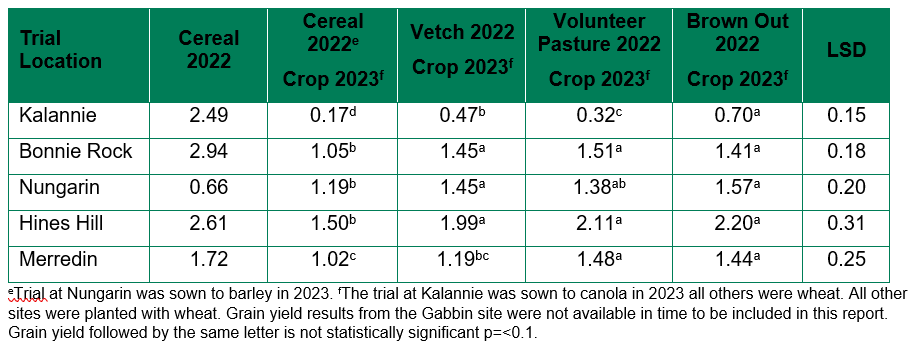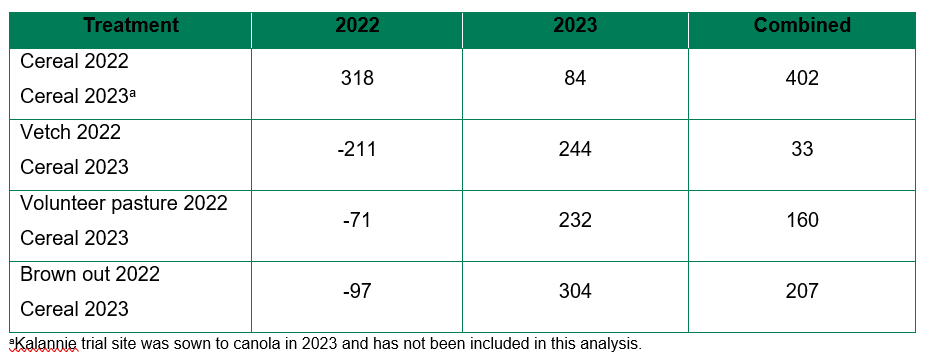Agronomic and economic benefits of fallow in the low rainfall zone of Western Australia
Agronomic and economic benefits of fallow in the low rainfall zone of Western Australia
Author: Darren Hughes, John Beech, Nick Hardie | Date: 26 Feb 2024
Key messages
- Growers considering fallow should implement a ‘brown out’ practice, keep paddocks weed free and maintain ground cover. This practice results in the highest amount of stored soil moisture, allows N to accumulate and be available for the following crop and provides an opportunity to control glyphosate resistant ryegrass.
- Saving 1mm of plant available water costs $4/ha.
- The cereal on cereal treatment recorded the highest gross margin. Despite the gross margin of the brown out practice being lower than cereal on cereal, feedback gathered from growers during the project suggests it does have a positive economic benefit to the farm system overall. Perhaps fallow is best considered a strategic investment and recorded as an asset on the grower’s balance sheet.
Aims
To determine the agronomic and financial benefits of different fallow management practices in the low rainfall zone of Western Australia.
Introduction
Growers in the low rainfall zone of Western Australia are interested in fallow. However, some growers are hesitant to adopt the practice because there are knowledge gaps regarding the best fallow system to adopt, the impact of different fallow systems on soil moisture, soil nitrogen, grain yield and quality, and the economic effects of different fallow systems.
Past research (Developing farming systems for the LRZ of WA - CSA00056) reported a 0.62t/ha grain yield increase in wheat after fallow compared to a continuous wheat rotation at Merredin. At Hyden, there was a 0.45t/ha increase in wheat yield in the fallow-wheat-fallow-wheat rotation compared to the continuous wheat rotation.
This paper reports the results of six farm-scale trials established in the eastern WA wheatbelt between 2022 and 2023. In 2023, an additional eight fallow trial sites were established. The results from these sites have not been reported but will be available in future Research Updates papers.
Method
In 2022, six farm-scale (plots 200m long x width of the grower boom spray, varying between 36m and 55m) trials were established, managed, and harvested using grower machinery. Trials were established near Kalannie (sandy loam), Gabbin (sandy loam), Bonnie Rock (sandy loam), Nungarin (clay/loam), Hines Hill (loam) and Merredin (loam).
Each trial had four treatments: 1) cereal, 2) vetch, 3) volunteer pasture, and 4) brown out. Wheat was sown at five sites, barley was sown at the Nungarin trial. The brown out treatment was kept weed-free all growing season. The volunteer pasture and vetch treatments were sprayed before seed set in late August/early September. All treatments were kept weed free over the 2022/23 summer.
In 2023, the trials were managed ‘as-per-grower practice’. The trial at Kalannie was sown to canola, all remaining trials were sown to wheat.
To determine the effect of different treatments on soil moisture, all trials were sampled in October 2022 and April 2023. Each plot was sampled in 100mm increments down to 600mm. In April 2023, each plot was sampled in 100mm increments down to 300mm and analysed for nitrate and ammonia to determine soil nitrogen (N) levels.
At harvest in 2023, grain yield was taken from each plot, a sample was collected and sent for analysis to determine treatment effects on grain quality.
A gross margin analysis was completed for each trial in 2022 and 2023 to compare the economic effects of different treatments.
Statistical analysis was completed using ANOVA at p>0.10. Analysis was completed across treatments at each site.
Results
Soil moisture
At the end of the 2022 growing season, the brown out treatment recorded the highest level of soil moisture, 24mm, 38% more than the cereal treatment. The cereal and vetch treatments recorded similar levels of soil moisture (Table 1). By April 2023, all treatments recorded similar levels of soil moisture (Table 2). Treatment differences recorded for the level of soil moisture in October did not carry over to April due to rainfall between November 2022 and April 2023. Rainfall varied between sites, ranging from 25mm at Kalannie to 128mm at Nungarin.
Table 1. Soil moisture (mm) to 600mm for each trial site in October 2022
| Trial Location | Cereal | Vtech | Volunteer Pasture | Brown Out |
|---|---|---|---|---|
| Kalannie | 44 | 57 | 60 | |
| Gabbin | 52 | 49 | 50 | 60 |
| Bonnie Rock | 45 | 47 | 50 | 78 |
| Nungarin | 88 | 84 | 107 | 114 |
| Hines Hills | 73 | 80 | 78 | 86 |
| Merredin | 73 | 86 | 104 | 99 |
Table 2. Soil nitrogen (kg N/ha) to 300mm for each trial site in April 2023
| Trail Location | Cereal | Vtech | Volunteer Pasture | Brown Out |
|---|---|---|---|---|
| Kalannie | 45 | 45 | 44 | 66 |
| Gabbin | 51 | 56 | 50 | 53 |
| Bonnie Rock | 56 | 64 | 64 | 47 |
| Nungarin | 91 | 103 | 116 | 110 |
| Hines Hill | 76 | 86 | 90 | 81 |
| Merredin | 104 | 104 | 69 | 88 |
Nitrogen (N)
The vetch and brown out treatments had similar levels of N in the soil, 14 and 15 kg N/ha, respectively. There was a slight increase in N in the volunteer pasture treatment compared to the cereal treatment, 5 kg N/ha (Table 3).
Table 3. Soil nitrogen (kg N/ha) to 300mm for each trial site in April 2023
| Trial Location | Cereal | Vtech | Volunteer Pasture | Brown Out |
|---|---|---|---|---|
| Kalannie | 15 | 17 | 18 | 24 |
| Gabbin | 29 | 37 | 40 | 36 |
| Bonnie Rock | 31 | 62 | 33 | 64 |
| Nungarin | 12 | 25 | 21 | 36 |
| Hines Hill | 16 | 30 | 11 | 25 |
| Merredin | 14 | 31 | 26 | 23 |
Grain yield and quality
The brown out and volunteer pasture treatments resulted in a grain yield increase of 0.43t/ha and 0.47t/ha, respectively, compared to the cereal on cereal treatment. This result is consistent with grower observations gathered during the project that yield increases in cereals following fallow are about 0.5t/ha. The yield increase in cereal following vetch was 0.33t/ha.
All fallow practices increased grain protein, this ranged from 1.18% in cereals grown after vetch to 0.45% in cereals grown after volunteer pasture.
Table 4. Grain yield (t/ha) for the cereal treatment in 2022 and all treatments in 2023
Table 5. Grain protein (%) in wheat sown in 2023 following the 2022 treatments
Economics
The cereal on cereal treatment was the most profitable ($402/ha) over the two years of the project. This was followed by cereal after brown out ($207/ha), cereal after volunteer pasture ($160/ha) and cereal after vetch ($33/ha) (Table 6).
Table 6. Gross margin ($/ha) analysis for each treatment
Conclusion
Based on the gross margin analysis, the most profitable practice for growers in the low rainfall zone is to grow cereal on cereal. However, this rotation is unlikely to be sustainable over the long term.
The brown out practice is the best option for growers looking to adopt fallow. This practice retains the most soil moisture, allows N to accumulate and be available for the following crop and provides an opportunity to control glyphosate resistant ryegrass.
This project has been extended until 2027, and all sites will continue to be monitored. More information on the agronomic and economic benefits of fallow will become available over the coming years.
Acknowledgments
The research undertaken as part of this project is made possible by the significant contributions of growers through both trial cooperation and the support of the GRDC, the authors would like to thank them for their continued support.
We would also like to thank Glenice Batchelor (MADFIG) for helping to find trial sites and the extension of results, Yvette Oliver (CSIRO) for analysing the soil moisture data and Glen Brayshaw (Planfarm) for guidance on the economic analysis.
Contact details
Darren Hughes
Laconik
22 Stirling Highway, Nedlands, WA, 6009.
Ph: 0436 115 642
Email: Darren.hughes@laconik.com.au
GRDC Project Code: LAK2204-002SAX,



